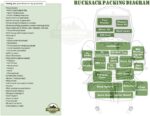How to Pack a Rucksack Army Strong

How do I pack a ruck sack in the Army? This is a question that gets asked by all infantrymen at some point in their career. Some of it is learned the hard way, or if you are fortunate a senior NCO will share some of his experience with you. Over the next few minutes, I am going to share with you some wisdom that I have learned over the course of 19 years in the Army. I will cover some tips for how to pack an Army rucksack, proper wear of the rucksack, a few comfort items you can purchase to make your ruck more comfortable, a common sense packing list, and the most current air assault school packing list.
What are the specs for the current US Army ruck?
19 Rucksack Packing Tips
The ruck sack weighs 8 pounds , making it a bit on the heavy side for civilian use. However, if you need something ultra durable and that can carry 100 lbs for 25 miles, this is the pack.
If you are in the Army, this is the only option you have, so wear it often and get used to it! You can check the price on Amazon by clicking here.
The ruck is water resistant, but I always waterproof my gear, as I explain in my tips section below.
The ruck sack has a capacity of 4,000 cubic inches by itself, add in two sustainment pouches on the sides at 500 cubic inches each and that’s a total of 5,000 cubic inches…a lot of room for your pogey bait.
You can also attach the Army Assault Pack to this ruck for an additional 2000 cubic inches, click here to see current prices on Amazon.
Tip #19 below has a link to the Technical Manual for more specs if you so desire…
OCP Army Rucksack
This rucksack is now issued in the new OCP pattern. Check them out on Amazon by clicking this link.
I have discussed at length with some of my peers and subordinates for the best tips on how to pack a rucksack and the following is what we have come up with:
1. USE A PACKING LIST.
This lists out everything you need to pack for the exercise or trip. Click the blue to download the Fort Campbell Air Assault School Packing List in PDF format last updated in August 2018. See below for my summer packing list, modify it for winter by adding intermediate sleeping bag, and some snivel gear.
I put together my own packing list and you can download a copy by clicking the picture on the right. It is common sense based, and has all the necessary gear required for summer exercises. If executing in the winter I would add some army snivel gear and possibly the intermediate army sleeping bag if it is cold enough to warrant the extra weight.
2. BALANCE THE RUCK DURING PACKING.
When packing your ruck sack lay it on the frame (back side down) as you place items in the ruck. This helps eliminate heavier items from shifting during the packing process. Ultimately you want to avoid greater weight all on one side or the other, which will put extra stress on one side of your body.
3. PACK HEAVIEST ITEMS TOWARDS THE BOTTOM AND AGAINST THE FRAME.
This allows the heavier items to rest toward the bottom and against your back, reducing stress on your shoulders. You want the weight to pull down not back on the shoulder straps. If you make the pack top heavy you are more liable to fall over to one side or the other if you lose balance.
4. SPARE AMMO GOES TO THE BOTTOM.
Pack spare ammo / mortar rounds first, then your sleep system in the area away from your back. This will allow you to unzip the quick access panel at the bottom, jerk out your sleeping bag and grab ammo quickly. Spare batteries should also be placed in the same area as the ammo.
5. EAR IN MIND TO PACK ITEMS YOU WILL SOON NEED TOWARD THE TOP.
Make sure to place items you will need soon after reaching the ORP or release point near the top for quick access. This allows me to whip those items out quickly when stopping for breaks or at the ORP.
6. ITEMS YOU MAY NEED DURING THE APPROACH MARCH GO IN THE TOP FLAP.
Place items you may need during your march at the top of a sustainment pouch or in the top flap for quick access. For me I normally put my foot powder, blister kit, 550 cord, and weapons cleaning kit in the top flap. An MRE in one of the sustainment pouches is also a good idea.
7 PONCHO SHOULD BE IN SUSTAINMENT POUCH FOR QUICK ACCESS.
Ensure your poncho is handy, so at the ORP you can pull it out and cover your rucksack if it is raining (make sure to tuck it all the way around your ruck). If it is cold, you may want to put your poncho on during the approach as well.
8. TAPE UP BOTTLES TO PREVENT A MESS.
Tape the tops of all your bottles to prevent spillage of pills, liquids, and powders. I use 100 mile an hour tape on foot powder, ibuprofen, and shaving cream.
9. ROLL ALL CLOTHING TO SAVE SPACE.
Roll everything that can be rolled to save space and reduce wrinkles. Some call this a “Ranger roll”, “sissy roll”, or “diddy roll”. I typically roll poncho, sleeping bag, uniform, t-shirts, socks, and underwear.
10. WATERPROOF YOUR SLEEPING BAG.
I put my army sleep system in the bivy bag, then stuff that in the compression sack it comes with. I do not put it in the wet weather bag, as this has usually kept it dry (I once “parked” my ruck in low ground at the ORP and came back to it filled with water, that is the only time it got wet). Also, bear in mind your sleep system is usually the first thing to go when other mission essential gear is required, or if you have a long distance to march. “Pack light, freeze at night”.
11. CAMELBACK SHOULD BE PLACED AT THE TOP OF RUCK.
Place your camelback at the top of the ruck with the straw over your right shoulder and hooked to the right shoulder strap for easy access during the march. Keeping the camelback at the top of the ruck provides better flow. The straw is also only so long and won’t reach well from the bottom of the ruck.
12. TEST BALANCE OF RUCK BEFORE MOVEMENT.
Ensure your ruck is balanced on the left and right once packed. Don your ruck and walk about a half mile to feel for any unbalances or shifting. Correct the unbalance by stuffing some clothing around objects.
13. TEST YOUR RUCK FOR NOISE ISSUES.
While you have your rucksack on, bounce and jiggle with it listening for any noise. Place some ranger rolls to separate ammo or anything making noise. If you have a heavy load your straps will squeak between the frame, a little Vaseline will stop it.
14. E-TOOL ON OUTSIDE OF RUCK
Your entrenching tool should be placed on the bottom side opposite your heavier gear on your tactical vest (IOTV or FLC). I place mine on the left bottom side, as on the right side of my FLC is a canteen and first aid pouch. This helps with the balancing act mentioned earlier. Your E-Tool will also get muddy when you get to your final destination and have to dig fighting positions. Keeping it outside the ruck will help keep other gear clean.
15. DON’T PACK EXTRA BOOTS
Packing an extra set of boots is OVERKILL. If your boots get wet, you wear them till they dry. If you change boots mid march the 2nd pair will be just as wet in 5 minutes. Boots are not light, and when was the last time your boots broke? Pack an extra pair of laces and save the weight.
16. WATERPROOF YOUR GEARarmy wet weather bag
Pack your Ranger rolls (underwear, socks, and t-shirts) in Ziploc bags, then sit on them to help squeeze the air out and zip up while sitting on them. Then I add them to my wet weather bag. I will put a few pairs of socks in Ziplocs and put in one of the sustainment pouches if I anticipate changing socks during the march (depending on time/distance). I put all other items that I want to keep dry in my wet weather bag. Some Soldiers use a heavy duty garbage bag , but I prefer the wet weather bag as it is much more durable. Army issued wet weather bags are on Amazon pretty cheap, click here to check.
17. TAPE THOSE STRAPS UP
Lastly, nothing says “newbie” more than 8 straps dangling off your ruck. Get some 100 mile an hour tape and tape those straps. If they are straps you need to adjust later use a cut piece of bicycle inner tube (Ranger Bands) or a rubber band to hold them rolled up.
18. USE THE KIDNEY BELT
The kidney belt is there for a reason. That reason is to take 80% of the pack’s weight off your shoulders (according to Outdoor Gear Lab) and transfer it to you hips, so your big leg muscles can do the work, not your small shoulder muscles.
19. MAKE SURE YOUR RUCK SACK IS PUT TOGETHER CORRECTLY.
I am currently on OC/T duty, and you wouldn’t believe the amount of rucksacks I see Soldiers wearing with incorrectly mounted shoulder straps, no kidney belt, ruck not attached to the frame right. Take 30 minutes, and read TM 10-8465-236-10 (MOLLE II) and learn the tools of your trade. Click the link above to download it.
In Closing…
There you have it 19 of the best tips I can come up with for packing a ruck sack. I plan to add some video in this article later (it’s currently too dark outside and I don’t have any lights suitable for video). If you have some tips or disagree with anything I have come up with let me know in the comments below. I might just add the tip or change my view on any of the above.
